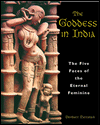
The Goddess of India by Devdutt Pattanaik details the role of women in Hindu culture based upon India’s mythologies, and introduces the Hindu religion to the Western reader in clear, understandable terms. Devdutt’s research draws directly from the epic poems of Hinduism as well as from folklore that many pundits (Hindu priests) do not acknowledge, in particular the tales telling how sexual mores came to change, eventually eating away the relative equality shared by men and women.
At the same time, however, Pattanaik’s work neglects to address that both the goddesses he researches and the traditions of Hindu women he examines are not just an ancient tradition, but a contemporary religion that is still evolving. While to the Western reader, the book’s heavily segmented chapters detailing one concept of the Goddess followed by a tale or anecdote about that Goddess makes the information more digestible, an Eastern reader and practicing Hindu finds the book inaccurate. She says Pattanaik neglects to address who Indian women are now. “It makes us all sound like we exist only in relation to men,” says Priyanka Suresh. “We aren’t just wives, mothers and whores and our goddesses aren’t merely consorts and vessels.” Men and women, according to modern Hindu tradition, are equal. Says Mansi Suresh, also a practicing Hindu, “that’s why every god in the male pantheon has a consort. He has to have a consort to be complete.”
Mansi particularly has issues with what she considers an outdated interpretation of Indian customs, and finds that the author confuses folk culture with religious culture. She points out that the author’s mentions of the caste system and sati are highly inaccurate. “The caste system was outlawed in India 57 years ago,” she says. “Yes, we still practice it as a social choice, but it no longer divides who we are or what opportunities we can pursue.” She also considers his explanation of sati as a way for a woman to preserve her family’s success incorrect. “Originally, a group of Hindu women burned themselves to avoid being taken into a harem during a Muslim invasion. Since then, some women were forced by their families to commit sati because of the prestige it brought their families. This practice today is now only performed if the woman chooses it. Few families see any prestige in forcing a woman onto the pyre.” Mansi also emphasizes that sati has also been outlawed.
The Goddess of India is a start for Westerners at comprehending the Hindu goddesses. However, no book, no matter how well-researched or well-written, can genuinely address the perceptual divide between East and West, and no book can replace learning about Hinduism in India by speaking directly to a practicing Hindu from India.
~by Diana Rajchel
by Devdutt Patannaik
Inner Traditions, 2000
pp. 176, $19.95
